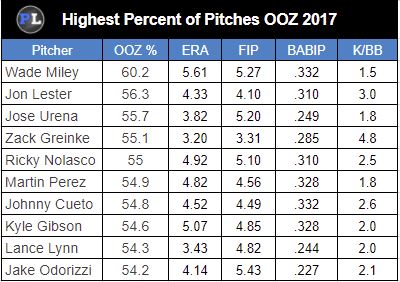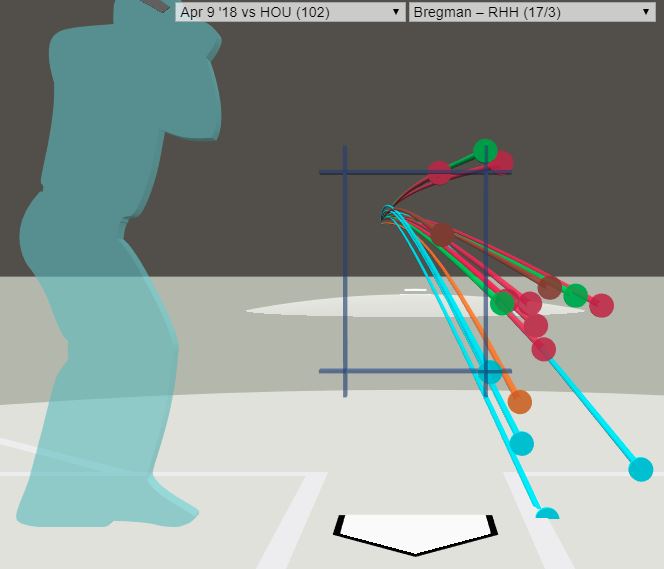(Photo by Justin Berl/Icon Sportswire)
Lance Lynn has a control problem and it’s ruining his relationship with the strike zone. Of all pitchers who have thrown at least 200 pitches in 2018, no other in baseball is throwing anywhere near as many pitches out of the zone as Lynn has; two out of every three to be exact. Take, for instance, his pitches during his last start against the Houston Astros.

You can’t throw strikes all the time; you’ll get rocked and your career in Major League Baseball will cease to exist. Pitchers tend to throw more out of the zone than in it but Lynn’s current rate is alarming. Bear in mind that league average pitches out of the strike zone are somewhere around 51%.
Let’s look at last season’s top-10 ratio of pitches out of the strike zone (minimum 2500 pitches) along with the pitcher’s success for the season.

We see Lynn ninth on the list. He had a decent year, save for his disconcerting FIP-ERA imbalance (which we’ll get to). And with the exception of Arizona Diamondbacks‘ starter Zack Grenkie, none of the pitchers in this group were especially successful. They had serviceable years for the most part but it would seem their lack of location was the main detriment.
Furthermore, Lynn hasn’t been the model of accuracy recently if your judging pitchers by their location ability; 6th in 2015 with 56.3%, 26th in 2014 at 53.4%, much better in 2013 with 51.1% of pitches out of the zone. That might make sense for a breaking-ball pitcher, but Lynn has (historically) leaned heavily on his fastballs.
Going back to the 3D pitch chart, Our pre-season assessment on Lynn’s repertoire jives with the location of his curveball (blue); not one of them landed in the zone. Historically, he’s kept his curve usage to under 10%. For whatever reason, he’s thrown it 16.5% thus far while reeling back on his two-seam fastball and cut fastball; both of which he’s had strong success with. His cutter speed has lost roughly 1MPH while his curve has gone up in kind. Yet as you see below, he isn’t having to compensate for any velocity loss.

Lynn’s .188 batting average against with a .263 BABIP indicates he’s getting (mostly) good results on contact. What’s alarming for Lynn is his 40% hard-hit rate (for those not in the know, a ‘hard hit’ is exit velocity over 95 MPH). His average is roughly 28% and that number has been steady throughout his career.
It’s only the first month of the season; things can change drastically in a start or two. So what have Lynn’s career numbers been like in March/April?
26 starts, 151.2 IP, 120 hits, 2.8 K/BB, 1.17 WHIP, 2.98 ERA
That time frame and July are Lynn’s most successful months. So that rules out his tendency for bad starts.
Whats more is he’s thrown exactly 200 pitches thus far…through just nine innings pitched. He’s laboring early and has faced 21 batters in both of his starts of five and four innings pitched, respectively. That’s an average of nearly five pitches per at-bat; league average is just under four. He threw 17 pitches alone to Alex Bregman for three at-bats during this last start against the Astros and 15 against Francisco Cervelli in two at-bats in his first start against the Pittsburgh Pirates. See the Bregman at-bats below; two walks on 12 pitches and a hit into out on five. The center red dot on the top of the zone was the groundout.

The only two hitters in the Astros lineup he gave good pitches to (thrown in the heart of the zone) was George Springer (six) and Marwin Gonzalez (five). So it’s not necessarily a case of Lynn being over-cautions with all the good hitters Houston has in their lineup.
Lynn was always a solid pitcher; kept the ball in the park, tendency for walks but always a counter-balance with strikeouts. One major deviation was Lynn’s BABIP; .244 in 2017 after maintaining slightly above and below .300 for the majority of his career. That could happen when a pitcher changes teams; likely to a much stronger defense. Lynn stayed in St. Louis, so did the Cardinals’ defense improve drastically? Not really; they were actually worse when you look at Inside Edge Fielding metrics, particularly the 1o% to 90% success chance plays. They averaged something in the neighborhood of 17 defensive runs saved prior to his lost 2016 season, and strangely enough, in 2017 they had 32.
Perhaps the main culprit was Lynn’s Tommy John surgery which cost him the entire 2016 season. He went from a 3+ WAR pitcher to 1.4 in 2017. Let’s compare/contrast his previous three seasons (2013-2015) pre TJ to last season; no sense in including the two starts in 2018 as that would skew the averages too much.

OK, so we see most everything is as its expected to be. The red flags come with a lowered strikeout to walk ratio, much higher FIP and double the average home run per fly ball rate. The hard-hit increase of less than two percent isn’t much but most of that is clearly the result of an elevated home run rate; 1.30 home runs per nine innings pitched after averaging something like 0.63. The only time Lynn ever approached one per nine was in his first full season in St. Louis (0.82 HR/9). His two worst games in 2017, a four home run game against the Baltimore Orioles and a three home run game against the Washington Nationals, all home run pitches were well inside the zone with the exception of one in the Baltimore game.
So when we look into his pitch selection, we see his four-seam usage in 2017 dropped nearly 20% from his career average, while he used his cutter a bit more and essentially doubled his use of the two-seam fastball. More interesting is he stuck with his trend of not using the curve much at all; a smart move given his 21.5% zone rate, 29% O-Swing percent, and the -2.5 pVAL.
And that is where we see a problem. In two starts, Lynn has tripled his use of the curveball. He’s brought back more of his four-seam fastball and basically cut out his change. As mentioned, just two of his curveballs landed in the zone with a third in the shadow of the zone. He’s not placing the pitch well at all and hitters aren’t getting fooled.
The Minnesota Twins have a pretty solid defense and he’ll need to trust them to get outs. He’s not helping anyone by giving out so many free passes, regardless of how much of a balance he can reach with strikeouts. If his early proclivities don’t adjust and the hard contact continues (despite his low BAA), Lynn may have trouble staying in the rotation.
Lynn needs to get back to his fastball. His two-seamer had roughly an 11-inch movement last season, which is much more than any point in his career. Save the curve for drawing swings when ahead in the count; he’s throwing them way too much and hitters aren’t biting.

Interesting analysis! I wonder if his pitch selection this season has to do with the lack of spring training? Maybe the change isn’t feeling sharp (though what is?)
Thanks for the work!
Thank YOU for the read and the feedback!
He also lost spring training so I am hoping that has something to do with it… either that or I am in trouble! The good news is that nobody had pay for him in their drafts… if he gets this figured out, then he can still be a good value. I don’t think anyone expects him to be more than a fantasy #4 and that is the high end – if you look at it like that, then the bar really isn’t that high and I think he can clear it. Personally, I own him as my #6 in a 20 teamer or two. He is only two starts in and he signed late so he is probably working through some things. I am not much more encouraged than you are, but I am holding out hope. Maybe the tinkering is actually the beginning of the end… that is typically what it looks like. Thanks for the article.
I agree. I think he might be messing with his pitches too much/overthinking it.
Thank you for reading!
Both games he pitched had a gametime temputure below 38*. Throwing strikes in weather like that is hard. I think he has a great start against the rays tmrw.
True, but a lot of pitchers work in the cold just fine. I mention that Mar/Apr (and July) are his best months; this hasn’t been the case this season (or last). The sample is very small. The next couple of starts will be telling.
Michael, For someone who is extremely passionate about baseball, I appreciate your work. This is great stuff. (Note: The Twins swing-and-miss a lot, are coming off a ‘celebrated series’ in P.R., which included a 16-inning game (those will wear on your ‘pen for a few days,) and Archer, other than a few innings vs. Philly last time out, has been adequate. He’s also a power guy with swing-and-miss stuff.
Thank you for that compliment. I have lots more to say, and so do the rest of the writing team, so keep coming back to read!